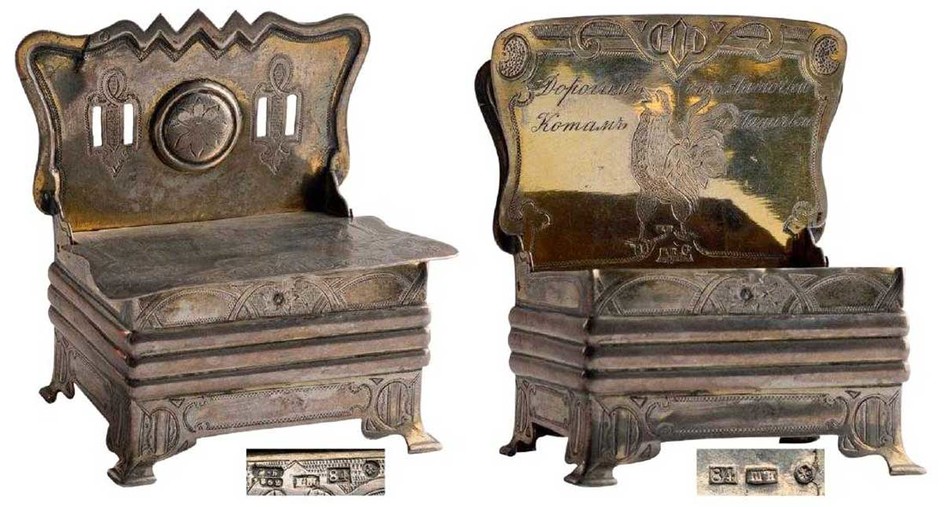RARE RUSSIAN IMPERIAL SILVER SALT CELLAR, 1862
RARE RUSSIAN IMPERIAL SILVER SALT CELLAR, MARKED, 1862
In the shape of a throne with a swivel seat, square base decorated with engraved geometric design, openwork back with engraving on the front: "Some bread and some salt for me, the truth for you", dedication "To the good tomcats, on behalf of Marutchka and Panitchka".
Nice motive of a rooster inside the lid.
Marked "84" for silver, standard guarantee, St. Petersburg 1862, silversmith "IsH" in Russian, assayer`s mark - I. Fedorovich Brandenburg.
SIZE: height 8 cm. Weight:150 grams.
ESTIMATE PRICE: $1500 - $2000.
HISTORY of SALES: A few years ago Russian silver salt cellars were sold on Live Auctioneer for $2850 and $3000 - please see the screenshots.
OFFER: If an item is NOT SOLD, you can still give us a reasonable offer - please save the link of this page.
PAYMENT: Credit Card payment, Wire transfer, Check or Money Order payment are also available.
SHIPPING: Let us Handle Your Shipping. We are one of the few places that offer full service shipping. For your convenience we will ship your item - shipping costs will be included in the invoice. Combined shipping is available - next item will be ONE DOLLAR for shipping.
NEW: Returning customers will have FREE SHIPPING in USA and 50% DISCOUNT on international shipping.
WIKIPEDIA: A silversmith is a metalworker who crafts objects from silver. The terms silversmith and goldsmith are not exactly synonyms as the techniques, training, history, and guilds are or were largely the same but the end product may vary greatly as may the scale of objects created. In the ancient Near East the value of silver to gold being less, allowed a silversmith to produce objects and store these as stock. Ogden states that according to an edict written by Diocletian in 301 A.D., a silversmith was able to charge 75, 100, 150, 200, 250, or 300 denarii for material produce (per Roman pound). At that time, guilds of silversmiths formed to arbitrate disputes, protect its members' welfare and educate the public of the trade. Silversmiths in medieval Europe and England formed guilds and transmitted their tools and techniques to new generations via the apprentice tradition. Silver working guilds often maintained consistency and upheld standards at the expense of innovation. Beginning in the 17th century, artisans emigrated to America and experienced fewer restrictions. As a result, silver working was one of the trades that helped to inaugurate the Technological and industrial history of the United States Silver-working shift to industrialization in America.
View it on
Estimate
Time, Location
Auction House
RARE RUSSIAN IMPERIAL SILVER SALT CELLAR, MARKED, 1862
In the shape of a throne with a swivel seat, square base decorated with engraved geometric design, openwork back with engraving on the front: "Some bread and some salt for me, the truth for you", dedication "To the good tomcats, on behalf of Marutchka and Panitchka".
Nice motive of a rooster inside the lid.
Marked "84" for silver, standard guarantee, St. Petersburg 1862, silversmith "IsH" in Russian, assayer`s mark - I. Fedorovich Brandenburg.
SIZE: height 8 cm. Weight:150 grams.
ESTIMATE PRICE: $1500 - $2000.
HISTORY of SALES: A few years ago Russian silver salt cellars were sold on Live Auctioneer for $2850 and $3000 - please see the screenshots.
OFFER: If an item is NOT SOLD, you can still give us a reasonable offer - please save the link of this page.
PAYMENT: Credit Card payment, Wire transfer, Check or Money Order payment are also available.
SHIPPING: Let us Handle Your Shipping. We are one of the few places that offer full service shipping. For your convenience we will ship your item - shipping costs will be included in the invoice. Combined shipping is available - next item will be ONE DOLLAR for shipping.
NEW: Returning customers will have FREE SHIPPING in USA and 50% DISCOUNT on international shipping.
WIKIPEDIA: A silversmith is a metalworker who crafts objects from silver. The terms silversmith and goldsmith are not exactly synonyms as the techniques, training, history, and guilds are or were largely the same but the end product may vary greatly as may the scale of objects created. In the ancient Near East the value of silver to gold being less, allowed a silversmith to produce objects and store these as stock. Ogden states that according to an edict written by Diocletian in 301 A.D., a silversmith was able to charge 75, 100, 150, 200, 250, or 300 denarii for material produce (per Roman pound). At that time, guilds of silversmiths formed to arbitrate disputes, protect its members' welfare and educate the public of the trade. Silversmiths in medieval Europe and England formed guilds and transmitted their tools and techniques to new generations via the apprentice tradition. Silver working guilds often maintained consistency and upheld standards at the expense of innovation. Beginning in the 17th century, artisans emigrated to America and experienced fewer restrictions. As a result, silver working was one of the trades that helped to inaugurate the Technological and industrial history of the United States Silver-working shift to industrialization in America.



